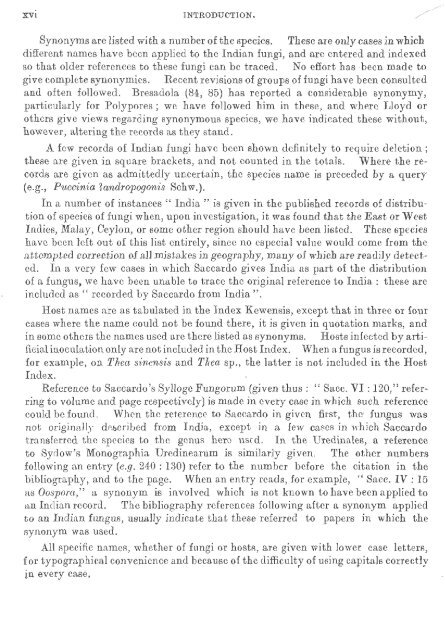IVRI B 407.pdf
IVRI B 407.pdf
IVRI B 407.pdf
Create successful ePaper yourself
Turn your PDF publications into a flip-book with our unique Google optimized e-Paper software.
xvi INTRODUCTION.<br />
Synonyms are listed with a number of the species. These are only cases in which<br />
different names have been applied to the Indian fungi, and are entered and indexed<br />
so that older references to these fungi can be traced. No effort has been made to<br />
give complete synonymies. Recent revisions of groups of fungi have been consulted<br />
and often followed. Bresadola (84, 85) has reported a considerable synonymy,<br />
particularly for Polypores; we have followed him in these, and where Lloyd or<br />
others give views regarding synonymous species, we have indicated these without,<br />
however, altering the records as they stand.<br />
A few records of Indian fungi have been shown definitely to require deletion;<br />
these are given in square brackets, and not counted in the totals. Where the records<br />
are given as admittedly uncertain, the species name is preceded by It query<br />
(e.g., Puccinia ?andropogonis Schw.).<br />
In a number of instances" India" is given in the published records of distribution<br />
of species of fungi when, upon investigation, it was found that the East or W cst<br />
Indies, Malay, Ceylon, or some other region should have been listed. These species<br />
have been left out of this list entirely, since no especial value would come from the<br />
attempted correction of all mistakes in geography, many of which are readily detectcd.<br />
In a vcry few cases in which Saccardo gives India as part of the distribution<br />
of a fungus, we have been unable to trace the original reference to India: these are<br />
included as " recorded by Saccardo from India".<br />
Host names are as tabulated in the Index Kewensis, except that in three or four<br />
cases where the name could not be found there, it is given in quotation marks, and<br />
in somc others the names used are there listed as synonyms. Hosts infected by artificial<br />
inoculation only are not included in the Host Index. When a fungus is recorded,<br />
for example, on Thea sinensis and Thea sp., the latter is not included in the Host<br />
Index.<br />
Reference to Saccardo's Sylloge Fungorum (given thus: "Sacc. VI: 120," referring<br />
to volume and page respectively) is made in every case in which such reference<br />
could be found. When the reterence to Saecardo in given first, the- fungus was<br />
not originally described from India, except in a few CI1tlCS in which Saccardo<br />
transterred the species to the genus here used. In the Uredinales, a reference<br />
to Sydow's Monographia Uredinearum is similarly given. The other numbers<br />
following an entry (e.g. 240: 130) refer to the number before the citation in the<br />
bibliography, and to the page. When an entry reads, for example, "Sacc. IV: 15<br />
as Oospora," a synonym is involved which is not known to have been applied to<br />
an Indian record. The bibliography references following after a synonym applied<br />
to an Indian fungus, usually indicate that these referred to papers in which the<br />
synonym was used.<br />
All specific names, whether of fungi or hosts, are given with lower case letters,<br />
for typographical convenience and because of the difficulty of using capitals correctly<br />
in every case,

















